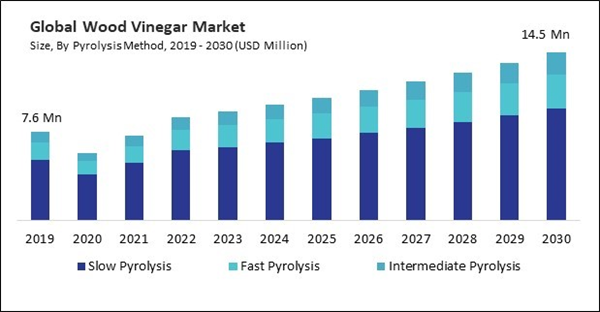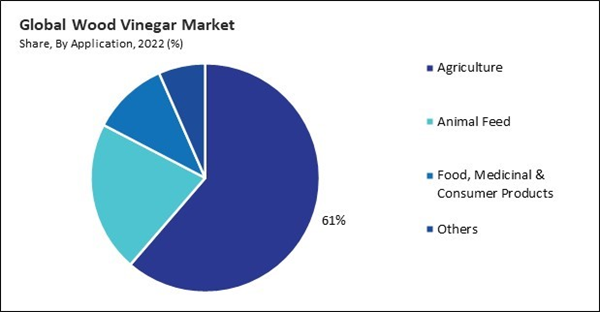The Global Wood Vinegar Market size is expected to reach $14.5 million by 2030, rising at a market growth of 6.4% CAGR during the forecast period. In the year 2022, the market attained a volume of 1583.48 Tonnes, experiencing a growth of 3.8% (2019-2022).
Wood vinegar exhibits natural insecticidal, fungicidal, and bactericidal properties, which can help control pests, diseases, and weeds in agricultural settings. This reduces the reliance on synthetic pesticides, thereby minimizing chemical residues and environmental pollution. Consequently, the agriculture segment would generate approximately 58 % share of the market by 2030. Also, China would utilize 391.79 Tonnes of wood vinegar in animal feed by 2030. Wood vinegar can stimulate beneficial microbial activity in the soil, promoting nutrient cycling, organic matter decomposition, and overall soil health.
Wood vinegar contains organic compounds such as acetic acid, methanol, and phenols, which can serve as plant nutrients. When applied to the soil, these compounds improve soil fertility and promote healthier plant growth. Wood vinegar also helps improve soil structure and texture by enhancing water retention and aeration. It also aids in the decomposition of organic matter, facilitating plant nutrient release and uptake. Therefore, owing to these factors, the market will witness enhanced growth in the coming years.
Additionally, Government policies promoting organic farming encourage farmers to transition away from conventional agricultural methods reliant on synthetic fertilizers, pesticides, and herbicides. As organic farming emphasizes the use of natural inputs and sustainable techniques, there is a growing demand for alternative products, such as wood vinegar, which aligns with the principles of organic agriculture. Regulations restricting the use of synthetic chemicals in agriculture create a demand for natural and eco-friendly alternatives like wood vinegar. Thus, these aspects can increase the demand for wood vinegar in the coming years.
However, Governments worldwide enforce stringent environmental protection regulations to mitigate the adverse effects of industrial activities. Wood vinegar production processes, particularly those involving pyrolysis, emit gases and byproducts that can contribute to air and water pollution. Compliance with emission standards, waste management protocols, and land-use regulations adds complexity and cost to production operations. Wood vinegar contains various chemical compounds from wood biomass, including acetic acid, methanol, and phenolic compounds. Regulatory agencies impose limits on the concentration and usage of these chemicals to safeguard human health and the environment. Hence, these aspects can hamper the growth of the market.
Wood vinegar exhibits natural insecticidal, fungicidal, and bactericidal properties, which can help control pests, diseases, and weeds in agricultural settings. This reduces the reliance on synthetic pesticides, thereby minimizing chemical residues and environmental pollution. Consequently, the agriculture segment would generate approximately 58 % share of the market by 2030. Also, China would utilize 391.79 Tonnes of wood vinegar in animal feed by 2030. Wood vinegar can stimulate beneficial microbial activity in the soil, promoting nutrient cycling, organic matter decomposition, and overall soil health.
Wood vinegar contains organic compounds such as acetic acid, methanol, and phenols, which can serve as plant nutrients. When applied to the soil, these compounds improve soil fertility and promote healthier plant growth. Wood vinegar also helps improve soil structure and texture by enhancing water retention and aeration. It also aids in the decomposition of organic matter, facilitating plant nutrient release and uptake. Therefore, owing to these factors, the market will witness enhanced growth in the coming years.
Additionally, Government policies promoting organic farming encourage farmers to transition away from conventional agricultural methods reliant on synthetic fertilizers, pesticides, and herbicides. As organic farming emphasizes the use of natural inputs and sustainable techniques, there is a growing demand for alternative products, such as wood vinegar, which aligns with the principles of organic agriculture. Regulations restricting the use of synthetic chemicals in agriculture create a demand for natural and eco-friendly alternatives like wood vinegar. Thus, these aspects can increase the demand for wood vinegar in the coming years.
However, Governments worldwide enforce stringent environmental protection regulations to mitigate the adverse effects of industrial activities. Wood vinegar production processes, particularly those involving pyrolysis, emit gases and byproducts that can contribute to air and water pollution. Compliance with emission standards, waste management protocols, and land-use regulations adds complexity and cost to production operations. Wood vinegar contains various chemical compounds from wood biomass, including acetic acid, methanol, and phenolic compounds. Regulatory agencies impose limits on the concentration and usage of these chemicals to safeguard human health and the environment. Hence, these aspects can hamper the growth of the market.
By Application Analysis
On the basis of application, the market is divided into agriculture, animal feed, food, medicinal & consumer products, and others. The agriculture segment recorded a 61.3% revenue share in the market in 2022. As a result of heightened environmental consciousness, the demand for organic and sustainable agricultural methods has increased significantly. Wood vinegar, known for its natural and eco-friendly properties, has emerged as a preferred soil conditioner, plant growth enhancer, and pest repellent in sustainable agriculture. Thus, these aspects can pose lucrative growth prospects for the segment.By Pyrolysis Method Analysis
Based on pyrolysis method, the market is segmented into slow pyrolysis, fast pyrolysis, and intermediate pyrolysis. In 2022, the fast pyrolysis segment garnered a 20% revenue share in the market. In terms of volume, slow pyrolysis method generate 6,027.81 tonnes of wood vinegar in 2022. Fast pyrolysis technology offers rapid thermal decomposition, allowing for high-throughput biomass conversion into wood vinegar. This efficiency and scalability make fast pyrolysis an attractive option for industrial-scale wood vinegar production, meeting the growing industry demand. Thus, these aspects will boost the demand in the segment.By Regional Analysis
By region, the market is segmented into North America, Europe, Asia Pacific, and LAMEA. In 2022, the Europe segment acquired a 14.6% revenue share in the market. The European Union (EU) has stringent regulations governing organic farming practices and agricultural inputs. Wood vinegar, a natural and organic product, has gained traction among organic farmers seeking compliant soil amendments and plant protectants. Europe boasts a strong research and innovation ecosystem, fostering advancements in wood vinegar production technology and applications. Thus, these aspects can lead to increased demand in the segment.List of Key Companies Profiled
- VerdiLife Inc.
- Sane Shell Carbon Pvt. Ltd.
- Ace (Singapore) Pte Ltd.
- Nettenergy BV
- TAGROW CO., LTD.
- Applied Gaia Corporation
- Penta Manufacturing Company, LLC
- Byron Biochar
- Taiko Pharmaceutical Co., Ltd.
- Doi Shoten Co., Ltd.
Market Report Segmentation
By Pyrolysis Method (Volume, Tonnes, USD Million, 2019-2030)- Slow Pyrolysis
- Fast Pyrolysis
- Intermediate Pyrolysis
- Agriculture
- Animal Feed
- Food, Medicinal & Consumer Products
- Others
- North America
- US
- Canada
- Mexico
- Rest of North America
- Europe
- Germany
- UK
- France
- Russia
- Spain
- Italy
- Rest of Europe
- Asia Pacific
- China
- Japan
- India
- South Korea
- Australia
- Thailand
- Rest of Asia Pacific
- LAMEA
- Brazil
- Argentina
- Morocco
- Chile
- South Africa
- Nigeria
- Rest of LAMEA
Table of Contents
Chapter 1. Market Scope & Methodology
Chapter 2. Market at a Glance
Chapter 3. Market Overview
Chapter 4. Global Wood Vinegar Market by Pyrolysis Method
Chapter 5. Global Wood Vinegar Market by Application
Chapter 6. Global Wood Vinegar Market by Region
Chapter 7. Company Profiles
Companies Mentioned
- VerdiLife Inc.
- Sane Shell Carbon Pvt. Ltd.
- Ace (Singapore) Pte Ltd.
- Nettenergy BV
- TAGROW CO., LTD.
- Applied Gaia Corporation
- Penta Manufacturing Company, LLC
- Byron Biochar
- Taiko Pharmaceutical Co., Ltd.
- Doi Shoten Co., Ltd.
Methodology

LOADING...










